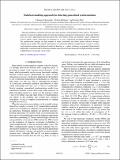Statistical modeling approach for detecting generalized synchronization
Author(s)
Haslinger, Robert Heinz; Pipa, Gordon; Schumacher, Johannes
DownloadSchumacher-2012-Statistical modeling approach for detecting generalized synchronization.pdf (913.5Kb)
PUBLISHER_POLICY
Publisher Policy
Article is made available in accordance with the publisher's policy and may be subject to US copyright law. Please refer to the publisher's site for terms of use.
Terms of use
Metadata
Show full item recordAbstract
Detecting nonlinear correlations between time series presents a hard problem for data analysis. We present a generative statistical modeling method for detecting nonlinear generalized synchronization. Truncated Volterra series are used to approximate functional interactions. The Volterra kernels are modeled as linear combinations of basis splines, whose coefficients are estimated via l[subscript 1] and l[subscript 2] regularized maximum likelihood regression. The regularization manages the high number of kernel coefficients and allows feature selection strategies yielding sparse models. The method's performance is evaluated on different coupled chaotic systems in various synchronization regimes and analytical results for detecting m:n phase synchrony are presented. Experimental applicability is demonstrated by detecting nonlinear interactions between neuronal local field potentials recorded in different parts of macaque visual cortex.
Date issued
2012-05Department
Massachusetts Institute of Technology. Department of Brain and Cognitive SciencesJournal
Physical Review E
Publisher
American Physical Society
Citation
Schumacher, Johannes, Robert Haslinger, and Gordon Pipa. “Statistical Modeling Approach for Detecting Generalized Synchronization.” Physical Review E 85.5 (2012): 056215. © 2012 American Physical Society.
Version: Final published version
ISSN
1539-3755
1550-2376